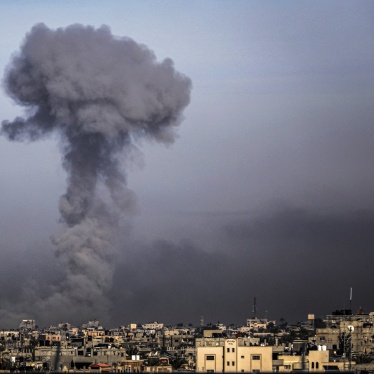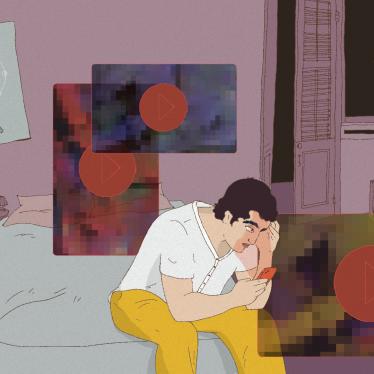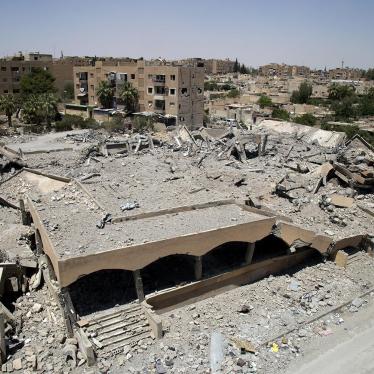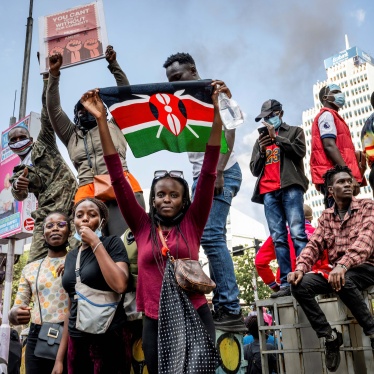(Beirut) – Iranian authorities have ruthlessly cracked down on widespread anti-government protests with excessive and lethal force throughout Iran, Human Rights Watch said today.
Based on videos of protests, and interviews with witnesses and a security force member, Human Rights Watch documented numerous incidents of security forces unlawfully using excessive or lethal force against protesters in 13 cities across Iran. Videos showed security forces using shotguns, assault rifles, and handguns against protesters in largely peaceful and often crowded settings, altogether killing and injuring hundreds. In some cases, they shot at people who were running away.
“The Iranian authorities’ brutal response to protests across many cities indicates concerted action by the government to crush dissent with cruel disregard for life,” said Tara Sepehri Far, senior Iran researcher at Human Rights Watch. “The security forces’ widespread shooting of protesters only serves to fuel anger against a corrupt and autocratic government.”
Protests began on September 16, 2022, after 22-year-old Mahsa (Jina) Amini’s death in the custody of Iran’s abusive “morality police”. Concerned governments should cooperate to increase pressure on Iran and undertake a United Nations-led independent inquiry into serious abuses committed during the protests and recommend avenues for holding those responsible to account.
Human Rights Watch verified 16 videos posted on social media that depict protests from September 17 to 22. The videos show police and other security forces using excessive and lethal force against protesters in Tehran, the capital, and the cities of Divandarreh, Garmsar, Hamedan, Kerman, Mashhad, Mehrshahr, Rasht, and Shiraz. They include instances of security forces using firearms, such as handguns and Kalashnikov-pattern assault rifles. Human Rights Watch also interviewed five witnesses to the crackdowns in Sanandaj, Marivan, Saghez, and Mashhad, and a security forces member.
Human Rights Watch also analyzed photos and videos showing grievous, and sometimes lethal, injuries to demonstrators. This research did not include the deadly crackdown by security forces in Zahedan on September 30, nor subsequent attacks against protesters, including on Sharif University Campus in Tehran on October 2.
Human Rights Watch compiled the names of 47 individuals whom human rights groups or credible media outlets documented as having been killed, most by bullets. These included at least nine children, two of them girls, and six women. As of September 30, Iranian state media-affiliated outlets reported the death toll to be around 60 and also announced the death of 10 security forces members. The death toll of protesters is likely significantly higher. Iranian authorities continue to heavily disrupt internet access in large parts of the country and block messaging applications, making documentation and verification more difficult.
“We had gathered to chant, [when] security forces on motorcycles came toward us,” said a 35-year-old year woman from Sanandaj city about a protest that took place near the Gendarmerie (Palestine) intersection on September 19. “We ran toward the alley as they followed us and started throwing teargas and some started shooting bullets. A man behind us was shot in the leg and fell on the ground. People dragged him into another alley and inside someone’s home. [...] His wound was bleeding very heavily and was very deep.”
In one video, filmed in Shahre-Rey city, south of Tehran, a security force member wearing camouflage clothing and surrounded by others in riot gear is seen aiming and firing twice with a Kalashnikov-pattern assault rifle at targets that are not visible. In another, filmed in the city of Rasht, a police officer leading a team of riot police is firing a handgun.
Human Rights Watch also reviewed and verified four videos of security forces firing at crowds of protesters, some fleeing. At least four videos showed security forces using shotguns, which can be loaded with ammunition containing multiple rubber or metal pellets. A security force member confirmed that police forces “typically use Winchester shotguns with different ammunition – rubber or metal pellets.”
A woman from Sanandaj city said that on September 21, security forces there directly shot at her upper chest using so-called “less lethal” ammunition, causing superficial injuries, when she asked them not to detain a teenager.
“[Security forces] ran toward a 13-year-old boy who was standing among the crowd,” she said. “He was so delicate and small that he didn’t even resist. He was on the grass protecting his head while they were beating him. I yelled ‘Leave him alone!’ and walked towards them. They fired in the air and people started fleeing while they dragged the boy across the street. While I was running, I kept yelling ‘He is my brother!’, thinking that was going to provoke their mercy. I saw an officer turning, sitting down, and aiming at me. I saw the fire from his weapon. I got scared and ran away. I had a burning sensation until I got home and realized that I was hit in my chest.”
The UN Basic Principles on the Use of Force and Firearms prohibit the use of firearms except in cases of imminent threat of death or serious injury. The UN Human Rights Committee, which monitors compliance with the International Covenant on Civil and Political Rights, has stated that “Firearms are not an appropriate tool for the policing of assemblies, and must never be used simply to disperse an assembly.… [A]ny use of firearms by law enforcement officials in the context of assemblies must be limited to targeted individuals in circumstances in which it is strictly necessary to confront an imminent threat of death or serious injury.”
The 2020 UN guidance on “less-lethal weapons” in law enforcement says, “Multiple projectiles fired at the same time are inaccurate and, in general, their use cannot comply with the principles of necessity and proportionality. Metal pellets, such as those fired from shotguns, should never be used.”
A woman in Saghez city, in Kurdistan province, said that on September 18, the second day of the protests in the city, security forces shot at their group of protesters when her friend started filming security personnel striking their batons at a house’s metal door, forcing them to seek refuge inside a nearby house. She said: “After some time when we felt that it was safe, we left the house, but security forces were hiding behind the trees at the end of the street and started shooting at us from behind as we were running away.”
Human Rights Watch examined two photos that Rohini Haar, an independent medical analyst, said showed protesters with serious injuries that are “diagnostic” of those sustained by metal pellets.
In two videos, one of them graphic, verified to have been filmed in the city of Kerman, demonstrators can be seen carrying away an unconscious woman bleeding from the head while a large crowd runs away.
Videos also show police officers and other security forces members, including plainclothes agents, operating side-by-side with the police, punching, kicking, and beating peaceful protesters and bystanders with batons. Police forces also used less-lethal weapons, including pepper ball launchers and riot guns.
The 35-year-old woman said that on October 1, she saw security forces attacking a group of women peacefully protesting in Sanandaj with metal cables and batons. She said that in response, “we also started protesting. They rushed towards us and the rest of the crowd. ... A person in plain clothes started hitting a woman. I went forward, I cursed him, I told him not to. He came back toward me and started hitting me with a metal tow cable. One of them grabbed my neck when I was leaving and the other two came and hit me one or two times.” She shared photos of hematomas on her back, arm, and abdomen that she said resulted from the beatings.
Human Rights Watch found that most protesters were peaceful, but some threw rocks and other objects. In some cases, protesters assaulted security forces. The use of violence by protesters does not justify the excessive use of force by security forces, Human Rights Watch said.
In Garmsar, graphic videos show security forces responding with automatic weapons fire to protesters attacking a police station with rocks and other projectiles. In one graphic video, a protester who appeared to present no imminent risk to security forces collapses immediately after gunfire is heard. A later graphic video shows the protester dead with a catastrophic injury to the head.
Since September 16, Iranian security agencies have also arrested hundreds of activists, journalists, and human rights defenders outside the protests. These include Niloufar Hamedi, a reporter of the Shargh Daily paper, and Elaheh Mohammadi, a reporter with Hammihan daily paper, both of whom reported on the death of Mahsa (Jina) Amini. Amini’s family requested the presence of independent medical reviewers to determine the cause of her death.
Under Iranian law, women who appear without “proper” hijab in public, based on the judgment of the country’s abusive “morality police,” can be fined or sentenced from between 10 days to two months in prison. Iran’s morality police regularly arrest women in public places. Over the past five years, authorities have prosecuted several activists, including the prominent lawyer Nasrin Sotoudeh as well as Yasman Ariani, Saba Kordafshari, Monireh Arabshahi, Mojgan Keshavarz and Farhad Meysami for their peaceful opposition to compulsory hijab laws.
Since the outbreak of the protests, Iranian authorities have heavily disrupted internet access across the country. They have blocked several social media platforms, including WhatsApp messaging application and Instagram, since September 21 by an order of Iran’s National Security Council. Over the past four years, Iranian authorities have used partial or total internet shutdowns during widespread protests to restrict access to information and prohibit dissemination of information, in particular videos of the protests, Human Rights Watch said.
Internet shutdowns violate multiple rights, including the rights to freedom of expression and access to information, and the rights to peaceful assembly and association. Under international human rights law, Iran has an obligation to ensure that internet-based restrictions are provided by law and are a necessary and proportionate response to a specific security concern. Officials should not use broad, indiscriminate shutdowns to curtail the flow of information, nor to harm civilians’ ability to freely assemble and express political views.
Over the past four years, Iran has experienced several waves of widespread protests. Authorities have responded to these widespread protests across the country with excessive and lethal force and the arbitrary arrests of thousands of protesters. In one of the most brutal crackdowns, in November 2019, security forces unlawfully used excessive and unlawful lethal force against massive protests across the country. Amnesty International estimated that at least 340 people were killed during the 2019 protests. Iranian authorities have failed to conduct any credible and transparent investigations into the security forces’ serious abuses.
“People in Iran are protesting because they do not see the death of Mahsa (Jina) Amini and the authorities’ crackdown as an isolated event, but rather the latest example of the government’s systematic repression of its own people,” Sepehri Far said.









